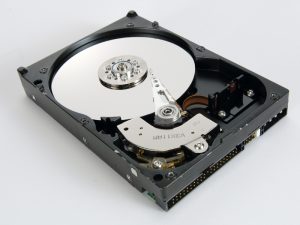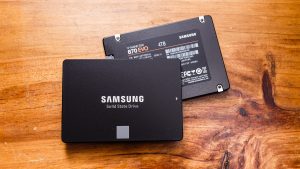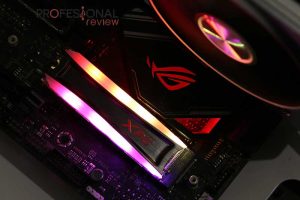Comprehensive SSD Buying Guide: Choose The Most Suitable Solid-State Drive With This Guide
Buying A Good And Reliable SSD For Your Gaming Or Rendering System Is A Key And Important Point. Your CPU, No Matter How Fast And Powerful, Can Do Nothing Without An SSD Drive That Can Deliver Data To The Processor Fast Enough.
SSD Buying, Many users are still using old mechanical drives or HDDs, but by 2021 we can confidently say that the era of these storage drives is over.
Now for users who have decided to upgrade their storage drive and are planning to buy an SSD, buying the right model becomes a real challenge. Today we are with you in Lyon Tech to provide a comprehensive guide to buying an SSD in 2021. Follow our SSD shopping guide.
What type of SSD does your computer support?
-

Farewell to old hard drives
SSDs are available today in various shapes and forms and can work with a variety of hardware connections. What kind of SSD you need to buy depends entirely on your computer and system. If you have a modern, high-end gaming system, or you want to assemble a PC with a mid-range or high-end motherboard, chances are your system will work with up-to-date and up-to-date drives.
In addition, modern laptops are equipped with M.2-shaped SSDs due to the more space occupied by SATA drives. Laptop manufacturers typically attach these NVMe SSDs to the laptop’s main board and do not allow the user to upgrade; So be careful that if you are a laptop gamer, be sure to check the exact specifications of the laptop SSD before buying.
What form factor do you need?
-

What form factor do you need?
SSDs are available today with three main form factors, but there is another form factor that is not common among users in addition to these three types. Let’s take a look at them:
Serial ATA (SATA)
The most common type of SSD is the SATA type. These drives look and feel like 2.5-inch mechanical laptops, and their connection type is the same as the older drives via SATA cable. If your laptop or desktop computer has a SATA connector, you can easily use this type of SSD and, due to their reasonable and relatively low price, experience a good and satisfactory upgrade over HDD drives.
SSD Add-in Card (AIC):
AIC drives have more capabilities than other types of SSD drives. Why? Because they connect to the motherboard via the PCIe port. Commonly used AIC SSDs have more PCIe lanes than the M.2 drive and are often used with the best and highest graphics cards or RAID controllers. However, to use AIC SSDs, you must assign a full x16 or x4 port to them.
M.2 SSD
-

970Evo
These types of SSDs, which look and feel like computer RAM (much smaller than RAM), have become a standard and ideal option for users these days, and in addition to new and modern laptops, they are also used in desktop computers. Since most motherboards today support this type of drive and even have more than one M.2 port, M.2 SSDs are much easier to use than before and can even be used in RAID configuration.
Most M.2 drives are 2280 in size (22mm wide and 80mm long), but larger or smaller models are also available for purchase. For example, 2230, 2242, 2260, 2280, and 22110 are other appearance forms of M.2 SSDs. The capacity of these drives starts from 128 GB and goes up to 8 terabytes. Users can purchase the desired model according to their needs and budget.
U.2 SSD
U.2 drives look like SATA SSDs at first glance, but they have different connectors and transmit data via a high-speed PCIe interface. These drives are also thinner and more compact than SATA drives. U.2 SSDs usually have a higher price, speed, and capacity than M.2 drives, are rarely used by ordinary users, and most servers take advantage of its capabilities. These storage drives are mostly found inside server motherboards and the like.
SATA or PCIe interface? This is the problem!
-

870Evo
This part of the story may be a little complicated. 2.5-inch SSDs are designed to work with SATA interfaces, and the SATA drive first develops in 2000 to run hard drives. M.2 drives, on the other hand, work with the NVMe interface in addition to the SATA interface, which is specifically designed to take advantage of high-speed storage. The downside is that the M.2 drive can be SATA based, or PCIe based and without NVMe support, or even PCIe based and with NVMe support! However, to avoid making things difficult for you, we must explain that in the consumer market (gamers and content producers), M.2 SSDs support NVMe.
If your day-to-day computer work is limited to office software, web browsing, or even gaming, NVMe SSDs are not necessarily different from cheaper SATA drives. Of course, given the development of video games, better use of NVMe drives will certainly occur in the coming years. However, شما Many of your needs are now being met with a low-cost SATA drive. But on the other side of the field, users transfer huge files to their computer daily or edit and edit images and videos with very high quality and volume. These people definitely need an NVMe SSD.
NVMe SSDs have 5 times the bandwidth of SATA models, and even if you use a fourth-generation PCIe interface, that bandwidth is up to 10 times that of a SATA drive. This type of high-speed SSD used to be sold at a high price until a few years ago, but now it has a more reasonable and affordable price.
What capacity do we need?
-

M.2 SSD XPG SPECTRIX S40G RGB
As mentioned, the capacity of SSDs starts from 64 GB and goes up to 8 terabytes, but considering the budget and needs, what capacity should we buy from the SSD? The 128 GB SSD is out of date from the start due to its shallow capacity for storing data and installing the operating system, and of course, the small number of memory modules (speed reduction). 256 GB SSD can also cause problems for you by considering the games and large files (remember the total size of Call of Duty Modern Warfare). The next step is the 512GB SSD, which is reasonably priced for good capacity, but these days 1TB drives meet all your needs without any problems.
1TB SSD, along with high speed, gives you a very acceptable and satisfactory capacity for the operating system, storing important information, and, of course, installing bulky games and applications. However, 2TB and 4TB SSDs (even higher) do not seem to be reasonably priced and do not become our first offer to buy. Our main suggestion for discussing capacity is to put the data used and read fast in your SSD and store the data (movies and serials and files used for a long time) to an HDD with Go high capacity.
What kind of memory (NAND Flash) storage do you need?
SSD memory is technically an important issue, but usually, users with any specialization do not pay any attention to this issue when buying an SSD. However, if you are curious about SSDs and the details of their memory type are important to you, do not miss this part of the article.
Single-Level Cell (SLC)
To start discussing the type of SSD memory, we must first go to the SLC and name its fast flash memory, which has been used for years. As the name SLC implies, this type of memory stores only one bit of data per cell. This memory is also high-speed and very durable. However, given the direction that the data storage debate has taken in recent years, the use of SLC is by no means cost-effective. Nowadays, SLC memory has been replaced by newer, more modern memory, except for expensive Enterprise drives and little use of Fast Cache.
Multi-Layer Cell (MLC)
After SLC, MLC memory was used for a relatively long time and became a popular choice for users as it could hold more data and cost less. However, MLC was slower than the previous type of memory; Many of these drives have a smaller SLC cache that acts as a write buffer. Today, except for a series of high-end drives (for consumers), MLC has been replaced by newer types of NAND memory.
Triple-Level Cell (TLC)
TLC still ranks lower than MLC in speed, but it is possible to store data with higher density and density. Most TLC memories (newer and more expensive models) use caching technology because TLC without a buffer is not as fast as mechanical hard drives. TLC has been a popular technology for many years, but advances in technology have found another competitor to this type of memory.
Quad-Level Cell (QLC)
SSD memory technology later became the de facto standard, completing the evolution of the SSD drive. QLC drives, as the name implies, are generally cheaper, more expensive, and more powerful (thanks to increased density). However, QLC memories are usually less durable, and their write speed decreases when the cache of these drives is full.
SSD durability; New story!
-

SSD durability; New story!
The durability and stability of the SSD may, along with the type of memory, be things that public users usually do not care about when buying. All flash drives have a limited lifespan. This means that after writing to a certain number of storage cells, the SSD can no longer hold the data. This is why manufacturers of SSDs usually try to communicate the lifespan of their drive to the consumer with Total Terabytes Written or TBW and Drive Write Per Day or DWPD units.
With all these interpretations, the end of SSD life is not so worrying. Why? This is because most drives support the Over Provisioning feature, which holds part of the overall capacity of the SSD as a backup. When the cells in the SSD start to die and fail, the drive intelligently transfers data from the dead cells to the new and backup cells, effectively extending the life of the SSD to some extent. With normal SSDs, all models today have a satisfactory lifespan and work well for at least 3 to 5 years. However, if the server uses your drive and the work of writing and reading information is done at all hours and days, you should be concerned about its lifespan.
If you plan to use your storage drive for years and the lifespan of 3 to 5 years seems short, it is better to avoid buying QLC drives and go for another type of drive. For example, Samsung’s Pro SSDs are generally durable and have a long warranty. Samsung also uses more advanced TLC to build some of its drives. However, we still say that ordinary users should not worry about the lifespan and durability of their SSD.
A word about DRAM
-

980pro
The DRAM in SSDs is actually a high-speed memory, like the RAM in your computer, and acts as a cache. Note that one byte can write to the SSD, but the data must write to a complete block, that data must delete, and new data must rewrite on the block. Most SSDs have this RAM, also known as DRAM. DRAM can permanently speed up data writing to SSDs.
DRAM can hold (cache) a large portion of data and then enter the process of reading, writing, and erasing it in the best and most efficient way possible. SSDs that do not have DRAM are very cheap and are useful for users with limited budgets. Of course, this type of SSD is still much faster than older mechanical drives, but their read and write speeds are much slower than DRAM SSDs.
Nutshell!
-

SATA Western and blue SSDs Western Digital
Now that we’ve talked about SSD storage in its entirety and the various forms of form factors and their memory, your way to buying an optimal SSD for your home or office system is undoubtedly clearer than ever. In general, buying an SSD with any form, type, and appearance will increase reading and writing information speed and bring you faster and better performance. However, gaining information and knowledge before buying any piece of hardware can help you a lot.
At the end of this article, let’s take a look at some of Lyon Tech’s approved SSDs so that this shopping guide can help you. More. The Samsung 870EVO 500GB SSD and the Kingston A400 SATA III 960GB SSD are good and reliable SATA drives that we recommend. If you have a more limited budget, the WD Green SATA3 480GB Western Digital SSD can be a boot option.
On the other hand, if you are not satisfied with the SATA drive and looking for a cheap and satisfying NVMe SSD, we recommend the Lexar NM610 M.2 2280 NVMe 500GB SSD. If you need a better SSD, the XPG SPECTRIX S40G RGB 512GB SDA Data is a good and beautiful option for you. Looking for the best NVMe drive with PCIe 3.0 interface? We definitely recommend the Samsung 970Evo Plus 1TB SSD.
Finally, if you have a completely modern motherboard with a PCIe 4.0 port, you can take advantage of fourth-generation PCIe SSDs, which, of course, are expensive despite their impressive read and write speeds. The Samsung S80 980PRO M.2 2280 NVMe 1TB is perhaps the best example of this category.













